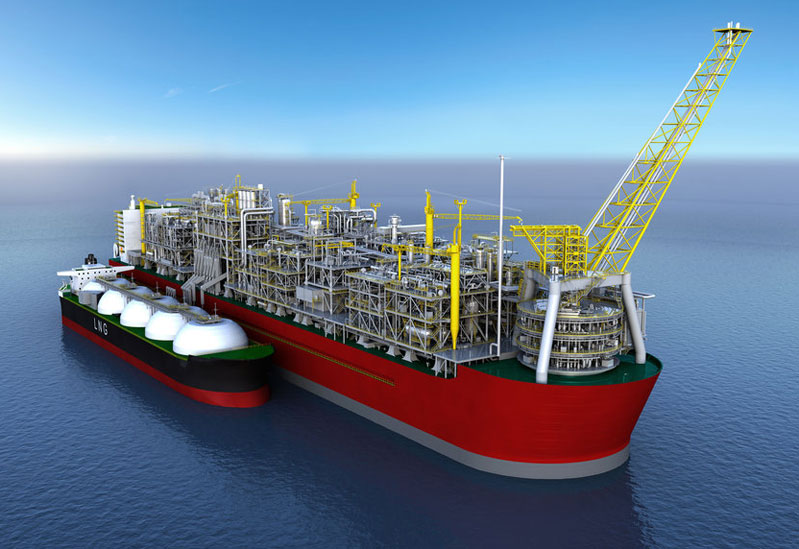Shell has confirmed the cutting of first steel for the game-changing Prelude floating liquefied natural gas (FLNG) facility’s substructure with joint venture participants, Inpex and KOGAS, and lead contractor, the Technip Samsung Consortium, at Samsung Heavy Industries’ Geoje shipyard in South Korea.
Shell’s Projects & Technology Director Matthias Bichsel commented: “We are cutting 7.6 tonnes of steel for the Prelude floating liquefied natural gas facility today, but in total, more than 260,000 tonnes of steel will be fabricated and assembled for the facility. That’s around five times the amount of steel used to build the Sydney Harbour Bridge. Today’s ceremony marks a major milestone in this project, when the innovative thinking and new technology and engineering solutions which will make FLNG possible begin to be realised.”
When completed, the Prelude FLNG facility will be 488 metres long and 74 metres wide, making it the largest offshore floating facility ever built. When fully equipped and with its cargo tanks full, it will weigh more than 600,000 tonnes. There will be over 3,000 kilometres of electrical and instrumentation cables on the FLNG facility, the distance from Barcelona to Moscow.
“Making FLNG a reality is no simple feat,” Matthias continued. “Shell is uniquely positioned to make it a success given our commercial capability; our LNG, offshore, deepwater and marine technology; and our proven ability to successfully deliver megaprojects.”
In order to meet the world’s growing energy demand, bringing new supplies to market is critical. The Prelude FLNG facility will be deployed in Australian waters over 200 kilometres from the nearest point on the coast. It will produce gas at sea, turn it into liquefied natural gas and then transfer it directly to the ships that will transport it to customers.
An expert team from Shell will manage the multi-year construction of the FLNG facility to ensure the Prelude project’s critical dimensions of safety, quality, cost and schedule are delivered. Strategic partners Technip and Samsung Heavy Industries (the Technip Samsung Consortium) along with SBM and hundreds of suppliers and contractors around the world are all contributing valuable knowledge, skills and equipment to help make the project a success. At peak levels, around 5,000 people will be working on the construction of the FLNG facility in South Korea; and another 1,000 will build the turret mooring system, subsea and wells equipment in other locations across the globe.
In the lead up to the facility being ready to start production, a number of actions will take place, such as drilling the production wells, installation of subsea flowlines and risers and mooring chains to prepare for the arrival of the FLNG facility.
Prelude FLNG is the latest in a line of Shell achievements in developing new technologies for the oil and gas industry, reinforcing its leadership in technology and innovation. This is the first of what Shell expects to be multiple Shell FLNG projects.
Prelude project background and key facts:
In 2012, Australian subsidiaries of INPEX Corporation (17.5%) and Korea Gas Corporation (10%) joined the Prelude FLNG project. An Australian subsidiary of CPC Corporation (5%) has also signed an agreement to do so. Completion of this transaction remains subject to conditions including Taiwanese government approval. By taking a stake in the project, INPEX, KOGAS and CPC show the confidence they place in Shell’s FLNG technology.
FLNG will enable the development of gas resources ranging from clusters of smaller more remote fields to potentially larger fields via multiple facilities where, for a range of reasons, an onshore development is not viable. This can mean faster, cheaper, more flexible development and deployment strategies for resources that were previously uneconomic, or constrained by technical or other risks.
Many of the technologies used on the FLNG facility are ones that Shell has used successfully onshore, but some have been extended or modified for offshore. The new technologies that Shell developed for FLNG include: managing sloshing in LNG tanks; systems for managing the close coupling between the producing wells and the LNG processing facility; LNG offloading arms; water intake risers; mooring systems; and the marinisation of processing equipment such as absorption columns and the main cryogenic heat exchangers. All of these technologies have been extensively modelled and tested to ensure they can operate safely and efficiently under marine conditions.




